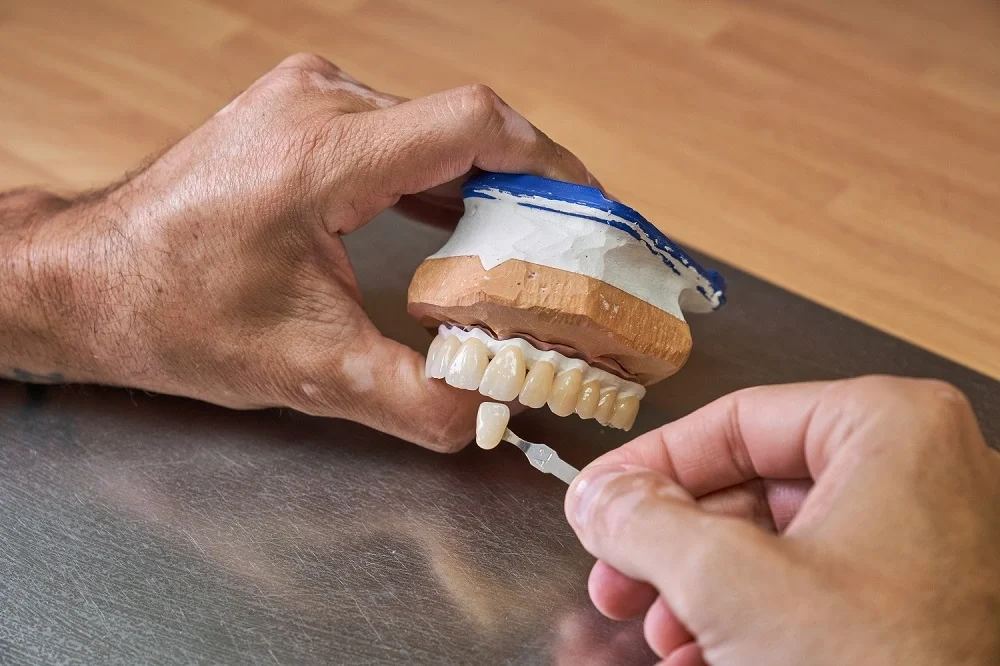Dental Veneers: What are they and how long do veneers last (Advantages and Disadvantages)

At present, dental veneers have been shown to be one of the most effective aesthetic treatments, offering better results to patients since they correct physical factors such as color, shape, and size. In the end, they serve to make a healthy and perfect smile, according to the person’s objective. With age, bad habits, or even due to accidental incidents, our teeth deteriorate: they lose color, become loose, wear down, and may chip. If you notice this happening and are worried about showing off your best smile, you may want to consider dental veneers.
It is a viable option for those uncomfortable with their smile. It is safe and minimally invasive. For best results, there are two types of veneers: porcelain and composite. They can be adjusted to the patient’s needs, depending upon the objective.
What are dental veneers?
Dental veneers are small thin sheets. They are custom-made to fit the teeth and look like part of the normal denture, without being noticeable. Veneers are bonded to the tooth enamel using a special compound. They change the shape, length, color, position, and surface texture of the teeth.
The purpose of applying veneers is to make the teeth look more harmonious, helping to correct common defects caused by habits, diet, or trauma, such as discolored, broken, crooked, separated, uneven, or worn teeth. Among the main goals are:
- Change the color of the teeth: Over the years, bad habits and the toll of genetics make the teeth acquire a yellowish or opaque color. Many times, traditional whitening does not work, making veneers the best option.
- Modify the shape of the teeth: Many people have very small or irregularly shaped teeth, which makes their smile unattractive, preventing them from laughing naturally. Clearly, there is a need for intervention.
- Reshape chipped teeth: Dental cracks can be an aesthetic problem for many people, making dental veneers are a very effective solution.
- Improve the alignment of the teeth: Aesthetic veneers are a way to straighten the teeth without having to place braces on them, as long as the occlusion allows it. In addition, they serve to correct spaces or diastemas. Of note, they are not recommended in children or young people since it is preferable to solve the problem with orthodontics.
- Modify damage due to bruxism: Bruxism is an anomaly or habit in which enamel loss and tooth wear usually occurs over time. With aesthetic veneers, you can modify or repair the damage it causes.
Types of veneers and how long do dental veneers last?

Depending upon the type of veneer and the degree of care, durability may vary. They come in porcelain, zirconium, composite or ceramic. However, according to the techniques used today, there are two main types: porcelain and composite.
- Composite veneers: these are a mixture of acrylic resin with ceramic particles of the color of the tooth. The dentist manufactures, molds, and applies them directly to the teeth, where he has previously placed an acid. An adhesive is applied to the resin to fix the veneers molded to the desired shape and size. To harden them, a photopolymerization lamp is used. It is possible that they may fracture, but with care, they could last between 5 -7 years.
- Porcelain veneers: Porcelain is a glass ceramic reinforced with materials such as leucite, which gives it the highest level of resistance possible, similar to tooth enamel itself. This type of aesthetic veneer is made outside the dental clinic; therefore the treatment is somewhat slower. They are the most resistant and last approximately 20 years.
- Zirconium veneers: This material is known to be very resistant and offers highly aesthetic results. However, they are more commonly used for dental crowns than veneers simply because they are more opaque and thicker than porcelain. They are very resistant and therefore their duration could be between 10 and15 years.
Durability also depends on good placement or the technique used by the dentist and then care of the patient. In the event that a veneer breaks or becomes detached, it is recommended to carefully store the piece and visit the dental clinic as soon as possible for repair and/or repositioning.
What is the procedure for placing dental folders?
According to the American Dental Association (ADA), the way the dental veneer procedure is performed depends upon the choice of the dentist.
Full veneer treatment generally requires three visits to the dentist:
- Diagnosis and treatment planning: At the first appointment and after an intraoral and radiographic examination, the dentist will ensure that dental veneers are the most appropriate treatment. It is vital during this first visit that you communicate your aesthetic expectations regarding the final result.
- Preparation: placing the dental veneer does not cause pain. However, to place them, it is necessary for the dentist to make a small carving on the surface of the teeth. There is minimal removal of enamel, similar to the thickness of the veneer. This process may cause some degree of pain in the teeth; therefore, it is normal to apply general anesthesia to numb the area. Subsequently, molds are taken and sent to the prosthetic laboratory for the fabrication of custom veneers. During the process, until the permanent veneers are placed, the patient wears temporary dental veneers.
- Placement and cementation: The first task is to clean, polish, and etch the tooth to achieve a rough surface that will allow a strong bond between the veneer and the tooth. Cement is applied to the veneer, which is then placed over the tooth. Once placed correctly, the dentist will apply a special beam of light to the veneer to activate the chemicals in the cement, causing it to harden. The final steps include removing any excess cement, evaluating the bite, and making final adjustments as needed.
It is possible that you will need to replace the veneers at some point in your life. Depending upon the material and care taken, the durability time will vary. You may need to replace a veneer for a number of reasons:
- Your gums may recede, and you see a different colored line since the tooth may have been stained.
- They may chip or break after many years of use.
- If the bite is not corrected or changes over time, it can cause a fissure or a fracture in the veneer, a risk for the development of caries.
Advantages and disadvantages of veneers
Depending upon the type of teeth and the oral health of each person, it is related to the type of veneer that should be used. Below, we list the most common:
Composite
Veneers are manufactured by the dentist; a highly aesthetic resin is used. This type of veneer is recommended especially for minor modifications such as touch-ups or when it is only one tooth.
Benefits of Composite
- Veneers can be easily reconstructed in the dental office.
- Treatment is faster since it can be done in a single visit to the dentist.
- The cost is less than porcelain veneers since they do not have to be sent to the laboratory for processing.
- They are easily repaired. They can be corrected or reshaped and restored in case of a fracture.
- Not aggressive or invasive. The tooth enamel is preserved, and they offer a great aesthetic result.
Disadvantages of composite veneers
- They are less durable than ceramic veneers.
- They are less resistant to staining. Over time, these veneers lose their shine or darken, especially in smokers or those who drink a lot of coffee or wine.
- They are not recommended for extensive treatments as in case of bruxism or to counteract habits such as biting nails or objects.
Porcelain or ceramic veneers
For these veneers, the process is more complex. They must be manufactured externally and possibly installed in several sessions with the dentist. The moment they bond with the teeth, they become resistant to fracture.
Advantages of porcelain or ceramic veneers
- Very high dental aesthetics and resistance to staining. The aesthetic result of porcelain veneers is greater than composite veneers. Ceramic veneers retain a natural and long-term color since ceramic veneers do not stain over time.
- Suitable for multiple defects. Porcelain veneers can be used to improve the alignment of the teeth, improve the color, match the size of the teeth, and improve worn or fractured teeth.
- Helps strengthen the teeth. Ceramic veneers strengthen fractured teeth and restore their normal function. In addition, they can be used to restore dentition worn down by bruxism.
- Quick treatment and little recovery time. Porcelain veneers are fixed to the teeth and the recovery time is immediate.
- Longer duration than composite veneers.
Disadvantages of porcelain veneers
- High cost: these veneers are more expensive than composite veneers.
- A greater number of sessions are needed. Because porcelain veneers are made in a dental laboratory, the number of visits to the dentist is greater than with composite veneers.
- They do not allow later touch-ups. Unlike composite veneers, porcelain veneers cannot be changed in color or shape once placed.
In general, dental veneers are not for everyone. To put them on, the teeth must be in very good oral health. It does not mean that if there are cavities, they cannot be placed. It is simply that there first must be the required dental treatment to improve oral health. Therefore, they are not recommended for people with tooth decay greater than 50%, gingivitis, periodontitis, receding gums, or malocclusion.
What precautions should I take so as not to affect the useful life of the veneers?
Different factors affect the durability and aesthetics of veneers:
- The type of material you choose will determine the duration of the treatment.
- Regular check-ups with the dentist.
- The health status of your teeth and oral hygiene.
- The oral hygiene you apply after the placement of veneers is key. Brush twice a day, and use dental floss and mouthwash.
- In the case of practicing a sport, the use of protectors is recommended to avoid damaging veneers. It should also be used in the case of teeth grinding.
- Do not bite objects with your teeth, much less open things by using them as a tool.
- Avoid smoking, as it can stain veneers.
- Watch your diet, especially dark drinks (some colored drinks, coffee, tea, and drinks like wine, juices, and dark sodas), and note that too much sugar can be harmful as it can stain your veneers.
Contact us
If you have any questions about this or other topics, you can contact us at Channel Island Family Dental as well as our Facebook page. We look forward to your visit and we will make a timely diagnosis. Our dentists in Oxnard, Saint Paula, Ventura, Newbury Park, and Port Hueneme will be able to guide you towards the best treatment to take care of your health and give you back your best smile.
Bibliography
- Alothman Y, Bamasoud MS. The Success of Dental Veneers According To Preparation Design and Material Type. Open Access Maced J Med Sci. 2018 Dec 14;6(12):2402-2408. doi: 10.3889/oamjms.2018.353. PMID: 30607201; PMCID: PMC6311473. Accessed on Sep 23, 2022. Available at: https://www-ncbi-nlm-nih-gov.translate.goog/pmc/articles/PMC6311473/?_x_tr_sl=en&_x_tr_tl=es&_x_tr_hl=es-419&_x_tr_pto=wapp
- Beier US, Kapferer I, Burtscher D, Dumfahrt H. Clinical performance of porcelain laminate veneers for up to 20 years. Int J Prosthodont. 2012 Jan-Feb;25(1):79-85. PMID: 22259802. Accessed on Sep 23, 2022. Available at: https://pubmed.ncbi.nlm.nih.gov/22259802/
- Larson, J; Khosravi, R. How Long Can You Expect Veneers to Last? Healthline (Internet). Published on Nov 23, 2020, (Accessed on Sep 23, 2022). Available in: https://www.healthline.com/health/how-long-do-veneers-last4
- Boulandier, I; Quevedo, O. What are dental veneers: Advantages and disadvantages. Dentaly.org (Internet). Updated on Jul 26, 2022; (Accessed on Sep 23, 2022). Available in: https://www.dentaly.org/en/dental-veneers/
- Fletcher, J; Archibald, J. What to know about dental veneers. Medical News Today (Internet). Posted on May 29, 2020; (Accessed on Sep 23, 2022). Available in: https://www.medicalnewstoday.com/articles/dental-veneers
















